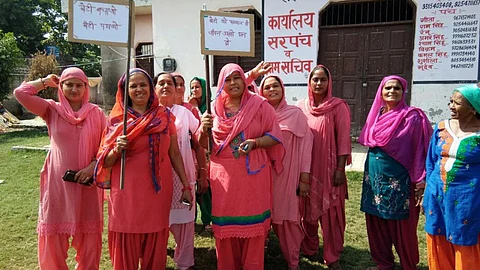
- Topics
- Feature
- Opportunities & Events
- About
- Hindi Portal
- Data
- Topics
- Feature
- Opportunities & Events
- About
- Hindi Portal
- Data

At just 24 years of age, Abhinav Vats has learnt a lot as the chief minister’s Good Governance Associate (CMGGA) posted in Palwal district of Haryana. An economics graduate from Delhi University, he worked as a research analyst with McKinsey and Company at Gurgaon for two-and-a-half years before deciding to be a CMGGA.
Designed as an experiential programme by Ashoka University in partnership with the Haryana government, CMGGA recruits young women and men to work with the deputy commissioner and other district officials. Backed by government support and resources, Vats began his work by understanding how the district administration functioned and the problems faced by it.
Palwal district is one of the more backward Haryana districts. When Vats joined 10 months ago, the administration was highly under-staffed, especially the departments in charge of rural development. “Last mile delivery of the existing central and state initiatives was way below targets. Administrative approvals were hard to come by. So, I innovated methods to leverage existing constraints,” says Vats.
John Nash’s Game Theory he learnt from textbooks stayed with Vats even after he graduated. Nash’s Game Theory creates mathematical models based on conflict and cooperation between rational decision makers. It assumes that all rational people are logical decision-makers and act in their own interest and that their interests can be aligned in a manner that one person's gain is not another person's loss. At McKinsey, he used it to understand the payoffs for choosing a particular strategy.
In the district administrative set-up, Vats used the Game Theory principles to design ‘Palwal super village challenge’ for last mile delivery of rural development schemes. His idea was backed by the deputy commissioner of Palwal, Maniram Sharma.
Vats says, “There are three agents who are critical to the delivery of any rural development programme—village sarpanch, district level scheme nodal officer and frontline workers for the department at the village level”. For a water and sanitation programme like the Swachh Bharat Mission, there are the village sarpanch, the CEO of the district panchayat/executive engineer of the rural water supply and sanitation department and the swachhagrahis, who are deployed at the village level as frontline workers.
“We worked on aligning the interests of these three agents and used technology to monitor the impacts. This ‘trinity of interests’ framework got the backing from the interdepartmental brainstorming sessions where select programmes were prioritised. The select schemes were—Swacch Bharat Mission — Rural, women empowerment (Beti Bachao Beti Padhao programme), digital literacy (PMGDISHA scheme), skill development (Rural Self Employment Training Institutes-RSETI scheme) and innovation (in areas of community welfare, technology etc.),” says Vats.
“The super village challenge launched in November 2017 used a competitive framework primarily targeted at village sarpanches for the speedier implementation of development projects at the village level. Each development area had a set of clearly defined parameters that had tasks. Successful completion of these parameters generates points for each gram panchayat,” says Vats.
“I had reserved an amount of Rs 1.5 crore from the D-Plan fund available to me. Top performing panchayats at the block and district orders were ranked and given work orders based on their rankings,” says Sharma.
Sharma adds that the announcement of Rs 1.5 crore additional fund from MP-LAD for top performing panchayats by Krishan Pal Gujjar, Minister of State for Social Justice and Empowerment during the award ceremony in February 2018, however, was completely unanticipated.
“Twenty development parameters were defined for the challenge and the entire competition happened digitally on a portal,” says Vats. A leadership index like in a stock market tracked the performance of villages and displayed panchayat rankings on a real-time basis. All the 260 panchayats in Palwal participated.
“We got login IDs and passwords for our panchayat. When a sarpanch felt his village was ready on a parameter, he made an online self-declaration. Within 15 days of the declaration, an on-ground inspection is conducted by the officer in the presence of the sarpanch. The officer then had to either pass or fail the panchayat. If a GP passed, points were awarded and changes reflected on the leadership index. In case of failure, the sarpanch could reapply later,” says Mehender Singh Gujar, sarpanch of Paroli.
Declarations and verifications were done on a continuous basis and top performing villages kept on changing. All GPs could view the ‘leadership index’. All panchayats have now been declared ‘polythene free’ by the district administration and over a hundred new self-help groups have been established and over a hundred schools and village libraries showed visible infrastructural improvements.
The administration has to now work on sustaining the developments on the ground to prevent slippages. “The super village challenge helped us generate a multi-faceted impact from the very same system, officials and sarpanches. This would not have been possible without the ground-breaking thinking brought in by Abhinav Vats,” says Sharma.
The ‘Palwal super village challenge’ is over but the village has to gear up for a clean-up as a routine to sustain the momentum. “We will use gram panchayat funds including MGNREGA allocation for swachhta (cleanliness),” says Mehender.
A cleanliness drive is on as I visit Paroli village. Plastic items are being removed from the village and surrounding areas. The blazing sun has brought with it unbearable heat but the sarpanch of Paroli is busy mobilising people to not revert to polythene bags and keep using alternatives.
“I want to join the non-profit sector preferably in a corporate foundation or a bilateral agency after this stint. The NGO work wouldn’t be backed by huge governmental or corporate support and resources and will not permit a wider social impact. I will still get a rich first-hand understanding of community needs before I can start my own social enterprise,” Vats says.
The super village contest has a website www.supervillagepalwal.in and a dedicated page on social media https://www.facebook.com/supervillagepalwal/